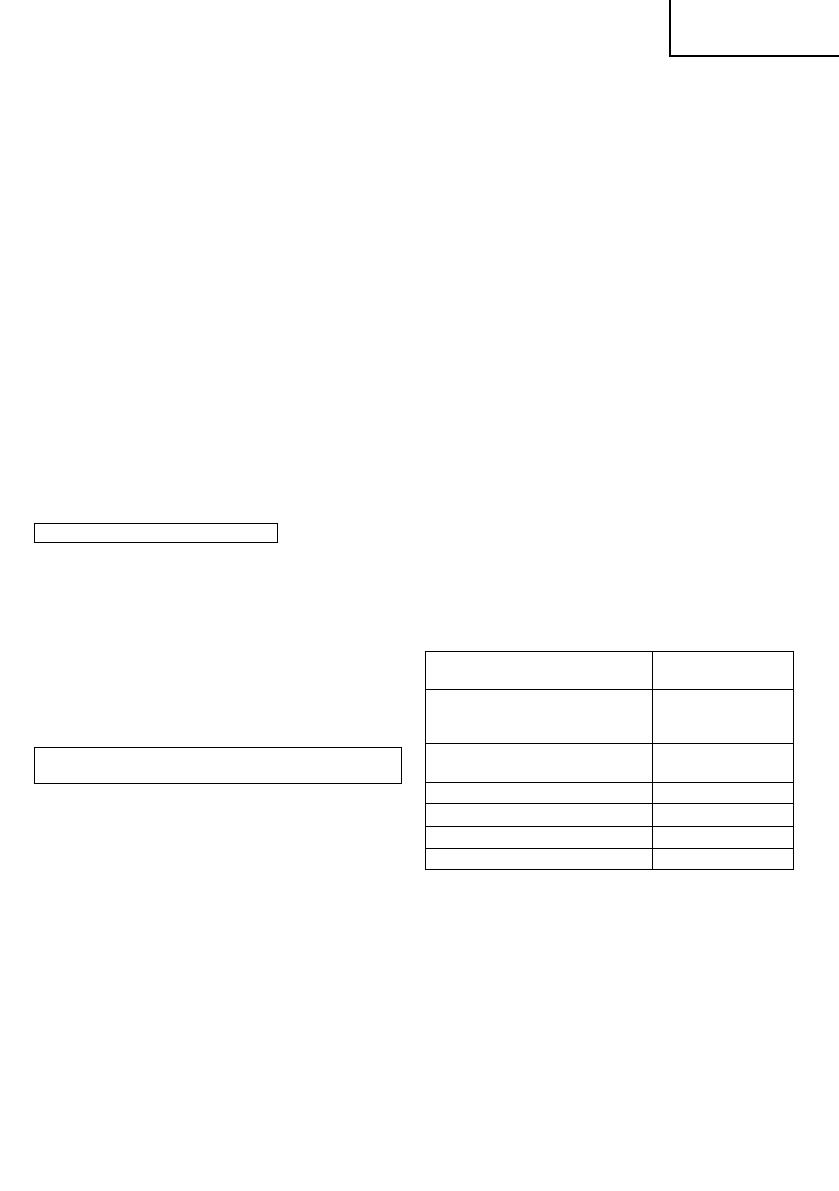
English
32
(4) When you release the lever, the spring force will
return the holder sleeve to the correct position
automatically. (Fig. 5)
(5) Pull the back of the saw blade two or three times
by hand and check that the blade is securely
mounted. When pulling the blade, you will know
it is properly mounted if it clicks and the lever
moves slightly. (Fig. 6)
CAUTION
When pulling the saw blade, be absolutely sure to
pull it from the back. Pulling other parts of the blade
will result in an injury.
6. Dismounting the blade
(1) Turn on and off the switching trigger several times
so that the lever can jump out of the front cover
completely. Thereafter, turn off the switch and
unplug the power cord. (Fig. 1)
CAUTION
Be absolutely sure to keep the switch turned off and
the power cord unplugged to prevent any accident.
(2)
After you have pushed the lever in the direction of
the arrow mark shown in Fig. 2, turn the blade so
it faces downward. The blade should fall out by
itself. If the blade doesn’t fall out, pull it out by hand.
CAUTION
Never touch the saw blade immediately after use.
The metal is hot and can easily burn your skin.
WHEN THE BLADE IS BROKEN
Even when the saw blade is broken and remains
inside the small slit of the plunger, it should fall
out if you push the lever in the direction of the
arrow mark, and face the blade downward. If it
doesn’t fall out itself, take it out using the procedures
explained below.
(1) If a part of the broken saw blade is sticking out
of the small slit of the plunger, pull out the protruding
part and take the blade out.
(2) If the broken saw blade is hidden inside the small
slit, hook the broken blade using a tip of another
saw blade and take it out. (Fig. 7)
MAINTENANCE AND INSPECTION OF SAW BLADE
MOUNT
(1) After use, blow away sawdust, earth, sand, moisture,
etc., with air or brush them away with a brush, etc.,
to ensure that the blade mount can function
smoothly.
(2) As shown in Fig. 8, carry out lubrication around the
blade holder on a periodic basis by use of cutting
fluid, etc.
NOTE:
Continued use of the tool without cleaning and
lubricating the area where the saw blade is installed
can result in some slack movement of the lever due
to accumulated sawdust and chips. Under the
circumstances, pull a rubber cap provided on the
lever in the direction of an arrow mark as shown
in Fig. 9 and remove the rubber cap from the lever.
Then, clean up the inside of the blade holder with
air and the like and carry out sufficient lubrication.
The rubber cap can be fitted on if it is pressed firmly
onto the lever. At this time, make certain that there
exists no clearance between the blade holder and
the rubber cap, and furthermore ensure that the
saw-blade-installed area can function smoothly.
CAUTION:
Do not use any saw blade with a worn-out blade
hole. Otherwise, the saw blade can come off,
resulting in personal injury. (Fig. 10)
7. Adjusting the base
This unit employs a mechanism that can adjust the
base mounting position in three stages without the
use of a wrench or other tools.
(1) Press a pushbutton. When you do this, a base lever
will jump out to prepare the base for adjustment
(Fig. 11)
(2) Push up the base tip and jog the base back and
forth. (Fig. 12)
(3) You can adjust the base position in three stages.
Move the base at an interval of about 15 mm, find
the position where the base hooks, and press in
the base lever with your fingers. The base is secured
when you hear the clicking sound. (Fig. 13)
8. Adjusting the blade reciprocating speed
This unit has a built-in electronic control circuit that
makes it possible to adjust the variable speed of
the saw blade either both by pulling a switching
trigger or turning a dial. (Fig. 14)
(1) If you pull the trigger further in, the speed of the
blade accelerates. Begin cutting at a low speed to
ensure the accuracy of your target cut position.
Once you’ve obtained a sufficient cutting depth,
increase the cutting speed.
(2) On the dial scale, “5” is the maximum speed and
“1” the minimum. The high speed is generally
suitable for soft materials such as wood, and the
low speed is suitable for hard materials such as
metal. We recommend that you use the following
as a rough guide in selecting the suitable speed
for the materials you are cutting.
CAUTION
䡬 When cutting at low speed (scale of 1 – 2), never
cut a wooden board more than 10 mm thick or a
mild steel plate more than 2 mm thick. The load
on the motor can result in overheating and damage.
䡬 Although this unit employs a powerful motor,
prolonged use at a low speed will increase the load
unduly and may lead to overheating. Properly adjust
the saw blade to allow steady, smooth cutting
operation, avoiding any unreasonable use such as
sudden stops during cutting operation.
9. Adjusting the swing cutting operation
Two cutting systems can be selected with this unit.
The first is straight cutting, in which the saw blade
is moved linearly, and the second is the swing
cutting, in which the saw blade is swung like a
pendulum. (Fig. 15, Fig. 16)
Example of materials Recommended
to be cut dial scale
Mild steel pipes /
cast-iron tubes / 2 – 4
L-shaped angle steel
Wood / wood with nails
driven in
5
Stainless steel 1 – 3
Aluminum / brass / copper 2 – 4
Plaster board 4 – 5
Plastic / fiber board 1 – 3









